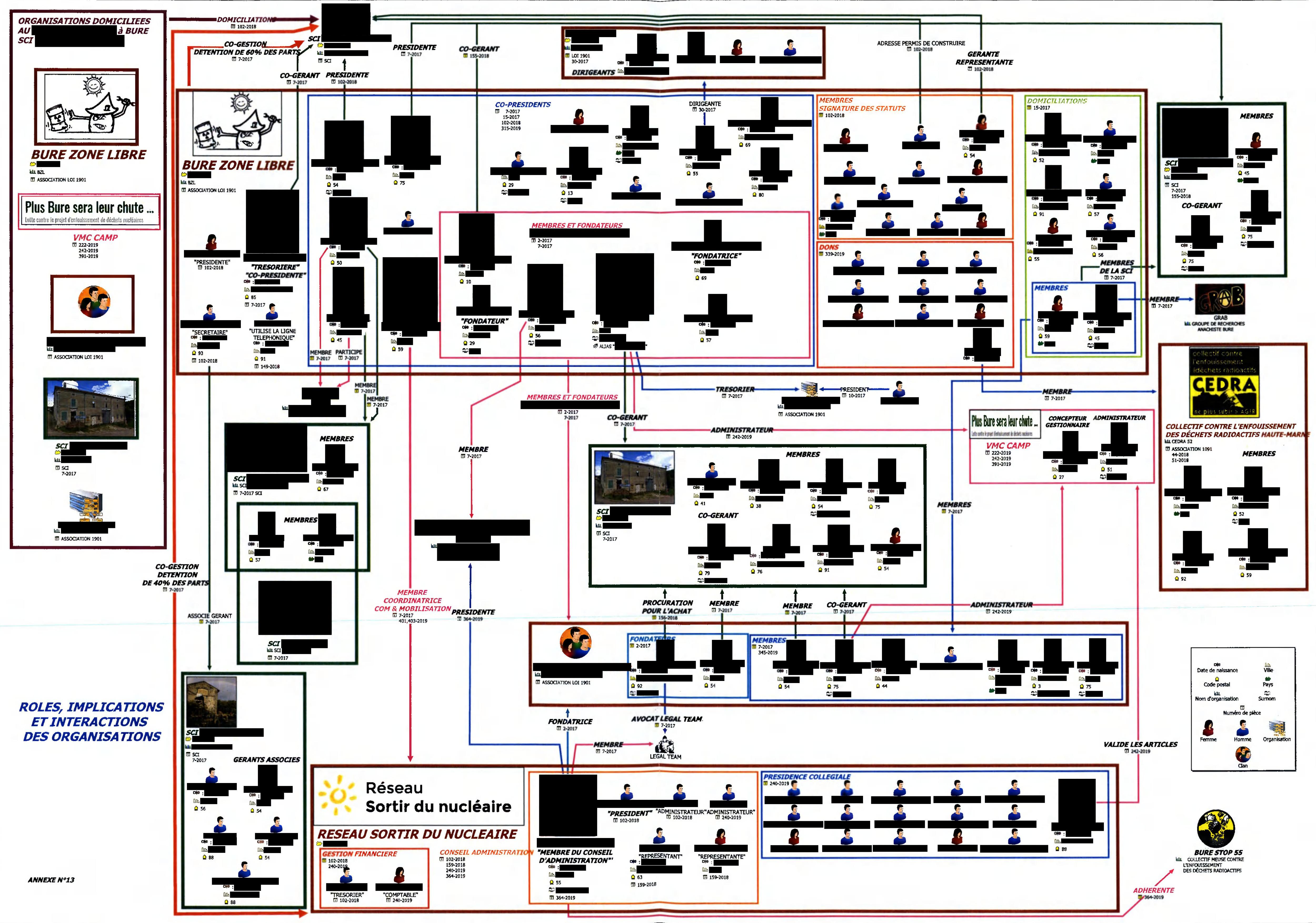
Diagram of the organizations fighting against Cigéo and their members, made by investigators (personal information censored by the No Trace Project).
In 2017 and 2018, around 20 house raids took place in France and around 10 people were arrested and accused of various crimes related to the struggle against Cigéo, a project to build a radioactive waste disposal facility in Bure, France.[1] Some of the people were accused of organizing or participating in demonstrations in which people attacked police forces and buildings associated with Cigéo, including a demonstration on June 21, 2017, in which a small fire broke out in a building while civilians were inside. Some of the people were charged with possession of explosive materials. Some were accused of being part of an association de malfaiteurs (criminal association).[2]
After a trial in 2021, an appeal in 2023, and another appeal in 2025,[3] everyone was acquitted.
Techniques used
| Name | Description | |
|---|---|---|
| Covert surveillance devices | ||
| Location | Investigators installed a covert location tracker on a vehicle, where it remained for about a month.[4] | |
| Detection dogs | Detection dogs were used in one of the raids.[4] | |
| Forensics | ||
| Arson | Traces of accelerants were collected from items recovered after demonstrations and analyzed.[4] | |
| Digital | Investigators analyzed storage devices by automatically extracting files containing the following keywords relevant to the investigation:[4]
| |
| DNA | DNA samples were collected from:[4]
Investigators were unable to match the vast majority of the DNA samples they collected to anyone. Notable exceptions were:
| |
| Fingerprints | Fingerprints were collected from items found during raids, including a notebook, sheets of paper, gas masks, helmets, Molotov cocktails, and containers filled with gasoline or other substances.[4] The vast majority of the fingerprints collected did not match anyone. Some of the fingerprints collected matched individuals in the national fingerprint database. | |
| House raid | During the raids, investigators found:[4]
| |
| International cooperation | Some of the people that were arrested had participated in demonstrations against the 2017 G20 summit in Hamburg, Germany.[4] Because of this, German investigators cooperated with French investigators, including by being present when the people were interrogated after their arrest. | |
| Mass surveillance | ||
| Police files | Investigators extensively used police files to establish links between people, including databases of driver's licenses and registered vehicles, as well as records of arrests, judicial proceedings and convictions.[4] | |
| Video surveillance | Investigators used footage from the demonstrations, recorded by surveillance cameras and police forces, to:[4]
| |
| Open-source intelligence | Investigators visited a Facebook page associated with the struggle against Cigéo and then analyzed the Facebook profiles of everyone who had “liked” the page.[4] | |
| Physical surveillance | ||
| Covert | Investigators:[4]
| |
| Service provider collaboration | ||
| Mobile network operators | Investigators used the collaboration of mobile network operators to:[4]
| |
| Other | Investigators used the collaboration of banks to obtain the bank records of organizations fighting against Cigéo.[4] The bank records of one organization included a 500€ transfer entitled “participation manif 18 fev” (“contribution to the February 18 demonstration”), in reference to a demonstration in which people attacked a building associated with Cigéo. The owner of a supermarket in a town about 20 km from Bure told investigators that he had seen customers buying an unusually large amount of denatured alcohol (15 liters), and gave the receipt to the investigators. | |
| Targeted digital surveillance | ||
| Authentication bypass | Investigators bypassed the authentication of five encrypted hard drives found in raids:[4]
| |
| IMSI-catcher | Investigators used IMSI-catchers to identify the phone numbers of people who lived in places associated with the struggle against Cigéo or who participated in demonstrations.[4] | |

 English
English